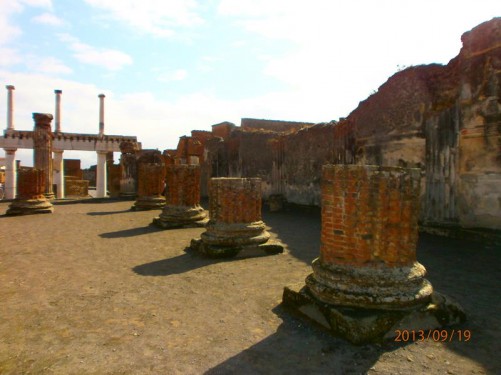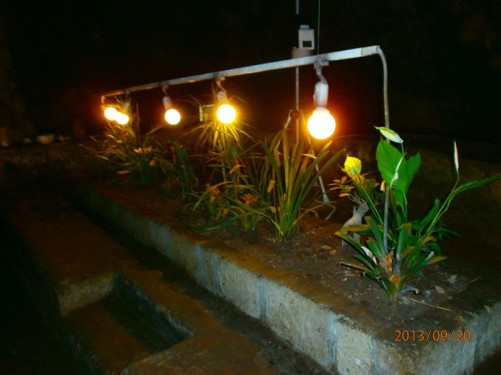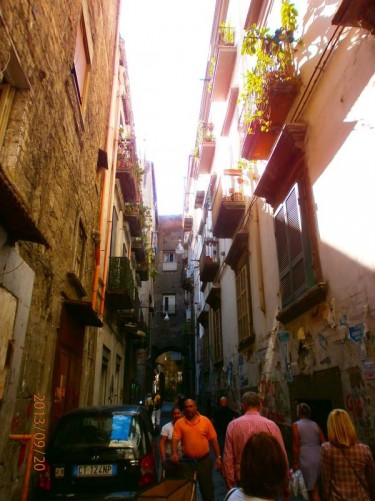Naples (Napoli)
Wednesday, 19th September
Capital of Campania region and the third-largest municipality in Italy and also the largest city in southern Italy. Situated on the west coast by the Gulf of Naples.
 Tony and Tatiana in Piazza Dante. The base of a 19th-century statue of Dante is behind. It was sculpted by Tito Angelini. Dante was a poet who lived between circa 1265 and 1321. His most famous work is the epic poem the Divine Comedy, which is often considered the pre-eminent work of Italian literature.
Tony and Tatiana in Piazza Dante. The base of a 19th-century statue of Dante is behind. It was sculpted by Tito Angelini. Dante was a poet who lived between circa 1265 and 1321. His most famous work is the epic poem the Divine Comedy, which is often considered the pre-eminent work of Italian literature.
 Looking up at the stone Dante statue itself.
Looking up at the stone Dante statue itself.
 Tatiana touching the flamboyantly decorated base to a lamp post. The metal moulding includes lion’s heads, leaf patterns and geometric decoration.
Tatiana touching the flamboyantly decorated base to a lamp post. The metal moulding includes lion’s heads, leaf patterns and geometric decoration.
 Washing hanging to dry from a balcony above a narrow street.
Washing hanging to dry from a balcony above a narrow street.
Thursday, 20th September
Pompeii
Pompeii was an ancient Roman town-city near modern Naples. It was founded in the 6th or 7th century BC, and abandoned in 79 AD when it was mostly destroyed and buried under four to six metres (13 to 20 feet) of ash and pumice following the eruption of Mount Vesuvius. Today, the archaeological ruins are a UNESCO World Heritage Site attracting 2.5 million visitors every year.
Audio guides are available either at the train station InfoPoint or at the official entrance. Get a five-site pass. Entry is free for disabled people, proof of disability required. On the Circumvesuviana Napoli-Sorrento train line it takes 30 to 40 minutes to get to Pompeii from either Naples or Sorrento, alight at Pompei Scavi. Go to the entrance at the Piazza Anfiteatro for disabled people. Email info@pompeiin.com or phone +39 3284134719 for a personal guide.
 Tony and Tatiana at the main entrance gate. They are at the bottom of a sloping covered passageway. The stone surface is rough with some steps. Lots of visitors are making their way up.
Tony and Tatiana at the main entrance gate. They are at the bottom of a sloping covered passageway. The stone surface is rough with some steps. Lots of visitors are making their way up.
 Tatiana and Tony at the Temple of Jupiter. The bases of large stone columns in a row behind. Some of the outer wall in the background. This temple is located at the north end of the forum. It was erected in the mid-2nd century BC.
Tatiana and Tony at the Temple of Jupiter. The bases of large stone columns in a row behind. Some of the outer wall in the background. This temple is located at the north end of the forum. It was erected in the mid-2nd century BC.
 Another view of the Temple of Jupiter and the forum beyond.
Another view of the Temple of Jupiter and the forum beyond.
 Tony and Tatiana touching a marble plinth. Probably the base to a statue.
Tony and Tatiana touching a marble plinth. Probably the base to a statue.
 Tatiana and Tony in front of an ancient brick wall. Up above are a row of columns, again part of the Temple of Jupiter.
Tatiana and Tony in front of an ancient brick wall. Up above are a row of columns, again part of the Temple of Jupiter.
 Tony and Tatiana touching a low wall with a series of large holes built into the top. This wall was used as a counter to sell food and drink, known as a thermopolium. It is topped with marble. The holes held terracotta containers.
Tony and Tatiana touching a low wall with a series of large holes built into the top. This wall was used as a counter to sell food and drink, known as a thermopolium. It is topped with marble. The holes held terracotta containers.
 Tony and Tatiana standing in one of the main streets. The road is paved with stone blocks.
Tony and Tatiana standing in one of the main streets. The road is paved with stone blocks.
 The Arch of Caligula. Tatiana and Tony standing underneath. The Arch of Nero is also visible further along the street.
The Arch of Caligula. Tatiana and Tony standing underneath. The Arch of Nero is also visible further along the street.
 Tatiana and Tony stood on rectangular stone blocks in one of the main streets. These allowed pedestrians to cross the street without having to step onto the road itself which doubled up as Pompeii’s drainage and sewage disposal system. These blocks also allowed horse-drawn carts carrying goods to use the streets. Mount Vesuvius is in background, but mostly obscured by cloud.
Tatiana and Tony stood on rectangular stone blocks in one of the main streets. These allowed pedestrians to cross the street without having to step onto the road itself which doubled up as Pompeii’s drainage and sewage disposal system. These blocks also allowed horse-drawn carts carrying goods to use the streets. Mount Vesuvius is in background, but mostly obscured by cloud.
 Again Tony and Tatiana on the stone blocks but looking in the other direction towards the Arch of Caligula.
Again Tony and Tatiana on the stone blocks but looking in the other direction towards the Arch of Caligula.
 Tatiana, Tony behind a Roman street fountain, once connected to an aqueduct. On top is an upright stone slab with a person’s face carved on the front. Water would have once come out of the mouth.
Tatiana, Tony behind a Roman street fountain, once connected to an aqueduct. On top is an upright stone slab with a person’s face carved on the front. Water would have once come out of the mouth.
 Inside a Roman bakery with a walled oven behind. Part of the Pistrinum (mill). There were also large flour grinders to the side.
Inside a Roman bakery with a walled oven behind. Part of the Pistrinum (mill). There were also large flour grinders to the side.
 Tatiana and Tony sitting on a round stone base. Perhaps the base of a column or some sort of pedestal.
Tatiana and Tony sitting on a round stone base. Perhaps the base of a column or some sort of pedestal.
 Inside a Roman bath house. A large marble fountain behind.
Inside a Roman bath house. A large marble fountain behind.
 Tony and Tatiana at the foot of marble steps used to enter a large bath.
Tony and Tatiana at the foot of marble steps used to enter a large bath.
 Still in the bath house. A room lined with a row of alcoves at head height. There are decorative stone-carved figures between each alcove.
Still in the bath house. A room lined with a row of alcoves at head height. There are decorative stone-carved figures between each alcove.
 Tony and Tatiana with their private guide. Stone columns and walls in the background.
Tony and Tatiana with their private guide. Stone columns and walls in the background.
 Tatiana and Tony back near the entrance. Good view of Mount Vesuvius in the background.
Tatiana and Tony back near the entrance. Good view of Mount Vesuvius in the background.
Salerno
Afternoon/evening. Historical old town. Salerno is connected by a regional train called U-5 Unico Campania, at one end of the Amalfi coastline.
 A sea front promenade, running parallel with Lungomare, a palm tree lined boulevard.
A sea front promenade, running parallel with Lungomare, a palm tree lined boulevard.
 View from the sea front. A harbour wall and the coastline beyond in the twilight.
View from the sea front. A harbour wall and the coastline beyond in the twilight.
 The masts of many yachts rising up from behind another harbour wall.
The masts of many yachts rising up from behind another harbour wall.
 A strip of park between the sea front promenade and Lungomare. People sitting on benches.
A strip of park between the sea front promenade and Lungomare. People sitting on benches.
Friday, 21st September
 A subterranean tunnel – part of Napoli Sotterranea – a labyrinth of tunnels and large chambers 40 metres beneath San Lorenzo Maggiore medieval church, located in Piazza San Gaetano in Naples. The tunnels were first hewn by the ancient Greeks to extract volcanic tuff stone. They were extended by the Romans who built conduits and large cisterns, part of an aqueduct system. More recently they were used as World War Two air raid shelters. The two-hour tour involves sliding through very narrow passages by candlelight only.
A subterranean tunnel – part of Napoli Sotterranea – a labyrinth of tunnels and large chambers 40 metres beneath San Lorenzo Maggiore medieval church, located in Piazza San Gaetano in Naples. The tunnels were first hewn by the ancient Greeks to extract volcanic tuff stone. They were extended by the Romans who built conduits and large cisterns, part of an aqueduct system. More recently they were used as World War Two air raid shelters. The two-hour tour involves sliding through very narrow passages by candlelight only.
 The stone floor of a partially lit tunnel. Tony’s white stick in front.
The stone floor of a partially lit tunnel. Tony’s white stick in front.
 A World War II era military tank, part of a war museum, displayed in an underground chamber.
A World War II era military tank, part of a war museum, displayed in an underground chamber.
 Behind a metal fence, more military artifacts, including an artillery shell.
Behind a metal fence, more military artifacts, including an artillery shell.
 Other visitors and a video display in the foreground. Further back, sandbags and fallen debris behind a barrier, part of the war museum.
Other visitors and a video display in the foreground. Further back, sandbags and fallen debris behind a barrier, part of the war museum.
 Three large old artillery shells suspended from the ceiling on wires.
Three large old artillery shells suspended from the ceiling on wires.
 A row of plants growing under artificial light.
A row of plants growing under artificial light.
 Another underground chamber. In front an old wooden barrel and wine press.
Another underground chamber. In front an old wooden barrel and wine press.
 A group of lit candles in pottery holders, left on an underground wall. These candles are carried by visitors.
A group of lit candles in pottery holders, left on an underground wall. These candles are carried by visitors.
 Tatiana and Tony squeezing along an extremely narrow passage between stone walls.
Tatiana and Tony squeezing along an extremely narrow passage between stone walls.
 Another view of Tony and Tatiana moving down the narrow passage.
Another view of Tony and Tatiana moving down the narrow passage.
 A water channel carved into the rock: part of a Roman aqueduct system.
A water channel carved into the rock: part of a Roman aqueduct system.
 At the side of a large cistern, again connected to the aqueduct system.
At the side of a large cistern, again connected to the aqueduct system.
 An old television, probably dating from around World War Two, with other furniture, in an underground room.
An old television, probably dating from around World War Two, with other furniture, in an underground room.
 A narrow bed and other furniture in an alcove.
A narrow bed and other furniture in an alcove.
 Tony and Tatiana at the end of a brick-lined underground tunnel. This is part of a recently discovered Greco-Roman Theatre, hidden underneath a typical Neapolitan house.
Tony and Tatiana at the end of a brick-lined underground tunnel. This is part of a recently discovered Greco-Roman Theatre, hidden underneath a typical Neapolitan house.
 Part of the Greco-Roman Theatre. Day light coming through a grill high above.
Part of the Greco-Roman Theatre. Day light coming through a grill high above.
 Another room that appears to be partially underground. Daylight can be seen from the top of steps in front. A stone built wall and ceiling above.
Another room that appears to be partially underground. Daylight can be seen from the top of steps in front. A stone built wall and ceiling above.
 Back outside into the day light. A narrow street lined with houses.
Back outside into the day light. A narrow street lined with houses.
 Into another underground room containing display cases filled with nativity scenes. These Neapolitan Christmas Crèches or presepi are a traditional craft item. The nearby small alley of Via San Gregorio Armeno is famous for shops that hand craft them.
Into another underground room containing display cases filled with nativity scenes. These Neapolitan Christmas Crèches or presepi are a traditional craft item. The nearby small alley of Via San Gregorio Armeno is famous for shops that hand craft them.
 Close-up of a skull cast in metal.
Close-up of a skull cast in metal.
Saturday, 22nd September (morning)
Sorrento
Located on the south side of the Bay of Naples, at the south-eastern end of the Circumvesuviana rail line (the opposite end from Naples). The town has good views over the bay to Mount Vesuvius and the Isle of Capri.
 A statue of Saint Antonino in Piazza Sant’Antonino. Saint Antonino died in 625. During his life he lived as a hermit and later settled in Sorrento and became abbot of the Benedictine monastery of San Agrippino. A miracle is attributed to him where it is said he saved a young child who had been swallowed by a whale.
A statue of Saint Antonino in Piazza Sant’Antonino. Saint Antonino died in 625. During his life he lived as a hermit and later settled in Sorrento and became abbot of the Benedictine monastery of San Agrippino. A miracle is attributed to him where it is said he saved a young child who had been swallowed by a whale.
 View along Corso Italia: Sorrento’s central street, lined with shops.
View along Corso Italia: Sorrento’s central street, lined with shops.
 Door to the Seminario Arcivescovile (Archbishop’s Seminary), located immediately next to Sorrento Cathedral (Duomo).
Door to the Seminario Arcivescovile (Archbishop’s Seminary), located immediately next to Sorrento Cathedral (Duomo).
 Yellow-painted façade of the Baroque style Church del Carmine in Piazza Tasso.
Yellow-painted façade of the Baroque style Church del Carmine in Piazza Tasso.
 Street with trees and a pair of houses painted pink immediately in front.
Street with trees and a pair of houses painted pink immediately in front.
Saturday, 22nd September (afternoon)
Herculaneum
Founded in the 6th-7th century BC, Herculaneum (Ercolano in Italian) was destroyed by volcanic pyroclastic flows from the eruption of Mount Vesuvius in AD 79. It is famous as one of the few ancient cities that can now be seen in almost its original splendour, because unlike Pompeii, its burial was deep enough to ensure the upper storeys of buildings remained intact, and the hotter ash preserved wooden household objects. Herculaneum was a wealthier town than Pompeii, with an extraordinary density of fine houses, and far more lavish use of coloured marble.
The site today is smaller and less crowded than Pompeii. The Circumvesuviana train takes 25 minutes from Naples and 40 minutes from Sorrento. Alight at Ercolano Scavi station, from where you exit into a small square. Cross diagonally right (the only way out of the square) and walk eight blocks downhill to the big arch: the ticket office and baggage check are about a further five minutes walk from the arch. Audio guides are available.
 View down into the site from a path on the edge.
View down into the site from a path on the edge.
 A walkway down into ancient Herculaneum.
A walkway down into ancient Herculaneum.
 Ruined walls of ancient buildings.
Ruined walls of ancient buildings.
 An altar inside the House of the Skeleton.
An altar inside the House of the Skeleton.
 Interior walls and doorways. House of the Skeleton.
Interior walls and doorways. House of the Skeleton.
 Close-up of part of a decorative wall-painting inside a house.
Close-up of part of a decorative wall-painting inside a house.
 View along an ancient street. The ruins of houses on either side standing to first floor level.
View along an ancient street. The ruins of houses on either side standing to first floor level.
 A pair of round holes on a flat surface. Perhaps a thermopolium with the holes used to hold amphorae (pottery containers used to transport wine and other liquid or dry goods).
A pair of round holes on a flat surface. Perhaps a thermopolium with the holes used to hold amphorae (pottery containers used to transport wine and other liquid or dry goods).
 View along a narrow Roman side street.
View along a narrow Roman side street.
 Row of ruined buildings: one with a modern metal roof to protect the interior.
Row of ruined buildings: one with a modern metal roof to protect the interior.
Sunday, 23rd September
Sant’Agnello
A village near Sorrento.
 A narrow street next to the parish church in Sant’Agnello.
A narrow street next to the parish church in Sant’Agnello.
 The town square. Steps up to the entrance to the Church of the Most Holy Prisco and Agnello on the left.
The town square. Steps up to the entrance to the Church of the Most Holy Prisco and Agnello on the left.
 A pair of doorways into the baroque style church. The building dates from the 15th century. The exterior is painted in yellow and white.
A pair of doorways into the baroque style church. The building dates from the 15th century. The exterior is painted in yellow and white.


